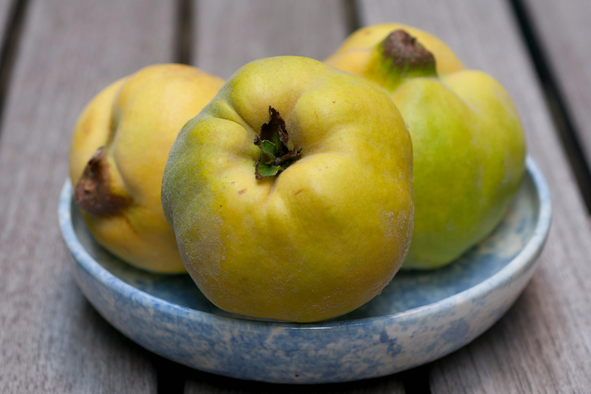
A rose is a rose is a rose, or so Gertrude Stein famously wrote in 1913, exactly a century ago.
She meant that things simply are what they are, but I’m here to disagree—especially when it comes to food. A spice’s scent can connect us to our past, a simple sandwich can link us to our communities, and a single piece of fruit can fill our minds as much as our mouths.
Peter Hoffman explores the last in his Ode to Quince, an homage in which he recalls first encountering the apple’s aromatic cousin 30 years ago. He writes:
“We were enthralled by the flavors, but just as importantly, by the idea of quince…that a locally grown fruit—of long-standing culinary tradition, outside of mainstream production, low yielding, excellent in flavor, not sweet and ready-to-eat, requiring patient slow cooking—would reward the cook and the diner with a singular taste experience. Quince expressed our journey as New York cooks looking for flavor and honesty in our work, newness without novelty.”
I didn’t come across quince myself until Peter had already been cooking it for 20 years, but when I did make its acquaintance at the Greenmarket’s Locust Grove stand, the knobby orb wearing a God-given fuzzy sweater and pineapply perfume was piled into a crate under a cardboard sign reading, “what Eve gave Adam.” Perhaps: quince was indeed immortalized in Greek mythology and may have been cultivated earlier than the apple.
Like that biblical forbidden fruit, one taste of quince gave me a new understanding of Earthly possibilities, but unlike Eve’s apple, this knowledge felt like a ticket into the Garden of Eden. I’ve since simmered up quince each November and, like Peter, see it as a symbol, embodying so many of the values that can’t be found in Styrofoam purgatory.
Quince isn’t the only nourishment in this issue that’s worth more than the sum of its nutrients. We also consider the cheesecake, which went from New York’s culinary icon to touristy cliché and back again. We bake with an artisan who uses only wild yeasts and finds meaning in the sound of a crackling crust. And we meet the farmers behind Niman Ranch and learn that all pork chops are not created equal—some are powerful tools for strengthening both rural economies and animal welfare.
I hope these stories inspire you to find more meaning in what you’re eating. If you’d like to start with Peter’s custard tart crowned with poached quince, we’ve posted the recipe at ediblemanhattan.com. Or just place a few of the fruits on your nightstand and dream of ancient orchards. And should you read Gertrude Stein, just remember that quince, like apples and pears, are in the rose family.
Gabrielle Langholtz
Editor
gabrielle@ediblemanhatthan.com



